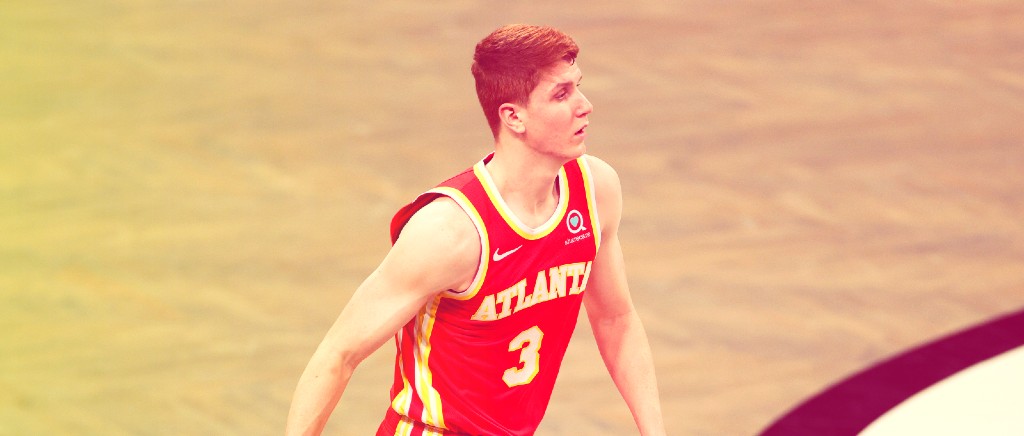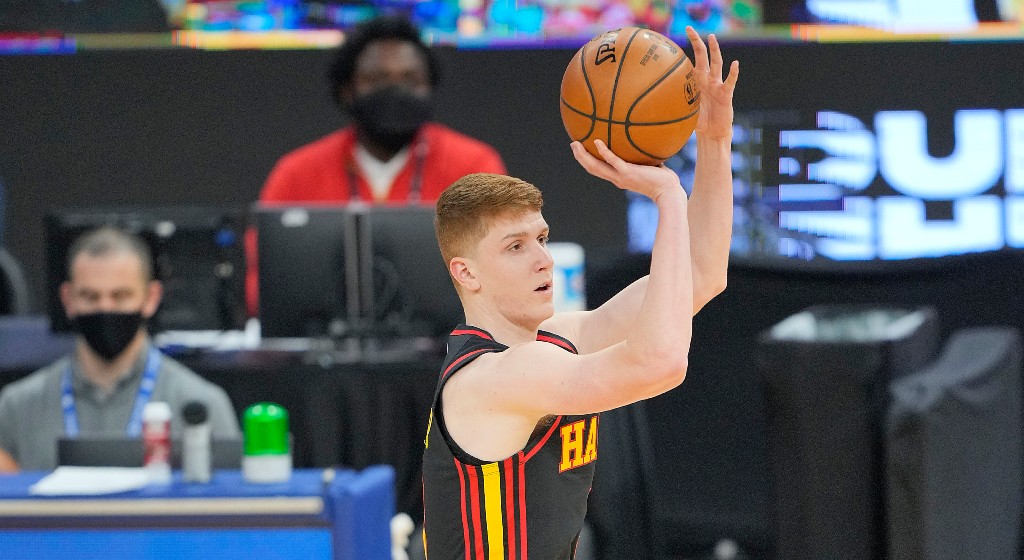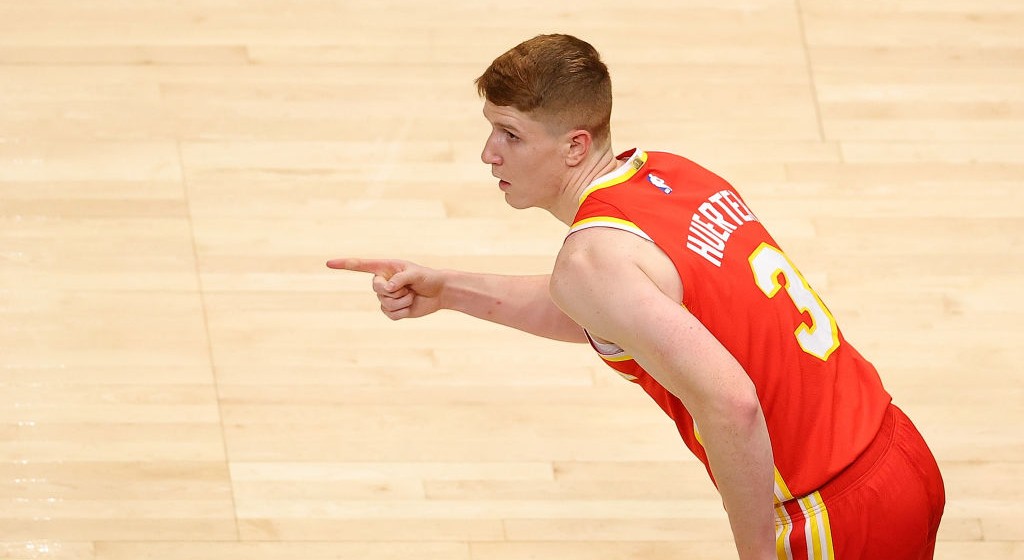
The necessary, if at times cruel, trick to success this season has shown to be a balance between resiliency and depth. For players, that’s been in staying versatile and stepping into new or additional roles when needed. For teams, it’s been plugging in that player versatility to create depth, especially in stretches where a roster has been temporarily thinned by positive testing or tracing for COVID-19. The Hawks, hit with player injuries and a head coach shuffle midseason, have harnessed both for a quiet propulsion that’s lifted them to a position of vying for a top-4 spot in the East, and a vital part of that engine has been third year guard, Kevin Huerter.
Huerter, 6’7” with reliably quick but unhurried shot, is a watchful player. In his two and a half seasons with the Hawks, Huerter has shifted regularly and fluidly between roles, developing his own overall versatility as much as he is helping to shape a young team working toward what its fixed identity could be. Huerter has said he enjoys not being pigeon holed into a specific role on court, a characteristic his former coaches attribute to his cerebral approach to the game. For Huerter, that analytical approach developed in learning from his dad, current AAU coach Tom Huerter, as much as it did out of early necessity.
“I think the first time I played for my own age group was when I was a senior in high school. That was the first time I started playing against kids my age,” Huerter says over the phone between games during the Hawks’ recent west coast road trip, “Growing up, I was always playing against guys bigger, stronger than me, older than me by multiple years. And so my advantage on the court was my mind, it wasn’t my athleticism or physicality at that point, it was just shooting the three and then just being smarter, and trying to find guys as a point guard.”
Primarily playing as point guard in those formative years gave Huerter the kind of birds-eye view of the game that shooting guards aren’t typically tasked with. It’s that same wide lens perspective that’s helped Huerter in what’s been his biggest jump in development this season — getting comfortable playing a much more physical game.
Earlier this year, former Hawks coach Lloyd Pierce urged Huerter to balance out his length, intelligence and positioning with physicality. With De’Andre Hunter and Bogdan Bogdanovic out for much of the early season, Huerter was tasked with guarding Bradley Beal and James Harden back to back at the end of January. Two tough defensive assignments under optimal conditions, let alone with a thin roster behind him, but Huerter held Beal to 26 points, his lowest scoring performance up to that point, and was able to pressure deflections from the perennially cool-headed Harden.
Some of Huerter’s improved in-game physicality comes from a shift in his diet this season, he’s cut gluten and fried foods completely, and from tapping into his natural vigilance and narrowing that scope on a hapless mark. But much more of it has come from study. Specifically, game tape — hours of it.
While the act of watching tape might be considered passive, the application of it is painstakingly physical. A millimeter tweak of an elbow here, the pivot of a foot there, the process of taking what are essentially split-second mistakes and adjusting them real time as the habits of your brain and body try and override you at every turn.
“It takes time,” Nate Babcock, special assistant for the Hawks says over the phone, “Because sometimes these movements aren’t natural to them, or something that doesn’t come naturally to them, they need to physically feel it. Sometimes they need to actually visually watch themselves do it. Kevin luckily doesn’t have a lot of bad habits. But he has some, and trying to re-break those down and build them back up again, it takes a little time.”

Time’s one thing Huerter’s had, even through an inconsistent last two seasons. Sidelined on and off with injuries in 2019-2020 (a left shoulder injury from a rotator cuff strain in November 2019, nagging right knee pain, an ankle sprain and groin soreness) Huerter didn’t get enough runway for his second NBA season to take off before the pandemic grounded the Hawks for good. With the recent changes to his diet Huerter notes he’s felt “explosive” on court and his ability to adapt has been a boon to his teammates, many recovering from the “injury bug” as Huerter calls it, where he’s stepped in and adjusted his role depending on what’s needed.
Sometimes what’s needed is the meticulously close study of himself on film, breaking it down “frame by frame,” as Babcock says, to show where he’s going right and where corrections are needed. Applying that film study in practice can go just as slow and is contingent on schedule, as they’re always trying to strike a balance between necessary rest during the season and putting in the extra work to make improvements.
“You gotta look at the schedule and figure out the windows of when you’re just lost in the moment, and then you take a breath and take a step back and assess where you are,” Babcock says of tacking an individual player’s progress to the team’s regimen. “In the middle of the season, it’s just so easy to get lost in the game. He might have 30 minutes the night before and then he’s going to play again the next night. Sometimes it’s just getting some quality feel of, ‘Kevin sit down, put your hips back, lift your leg over that screen’, and just feeling out the actual movements.
“You start slow so they can feel it, and then you speed it up, and then you put it into more dynamic setting, and that’s kind of how learning goes,” Babcock says, “But if you just kind of jump right into it without, you know, re-ingraining that habit, he’ll just go right back to his old habits, so you have to ingrain them a little bit, whether that’s mentally or physically before you go out there on court and do it.”
Aside from time, the process of breaking habits and making new ones also varies depending on the player. Babcock, who worked previously with the Nets, mentions Joe Harris as an example of a talented player with a streamlined role — shooting and cutting without much dribbling — who wouldn’t have the number of adjustments to make to his game as a player like Huerter, working to enhance his physical skillset, would.
“He has so many aspects of his game,” Babcock says, “So, as one gets better, you know, the other area might still be catching up while another one is still behind. Once Kevin’s getting all those areas to sync together, he’s just scratching the surface right now. So as he gets better in all these areas his improvement is going to grow exponentially. I forget sometimes he’s just 22 I have to remind myself of that because he’ll go through a stint where he’s not shooting the ball great and you got to remind him it’s not the end of the world and this is a five game window, and guess what? You’re gonna take a thousand threes in your career. Thousands of them. You can’t get focused on the one bad game, one bad week. I think he’s very good at doing that. Sometimes he needs a kick in the butt, and sometimes I do myself.”
On a team as young as the Hawks, who in 2020 had 75 percent of their minutes played by players with 3 years or fewer as professionals, energy and expectation don’t always align. Though the team is building toward both a fixed identity and the necessary sustainability it takes to last in the postseason, the Hawks are simmering in a sense of urgency. A kind of why wait energy, sparked by what’s been a solidly winning season despite their setbacks, that spirals off of them like bottle rockets whenever they hit the floor.
Control, then, becomes another thing to practice.
“A big thing that us and our coaches, that we talk about, especially my individual film, is you gotta be really efficient in your movements. And so that’s physicality, it’s also learning where to be physical, where you can’t be physical, using the right angles basketball-wise,” Huerter says.
It’s in recalling these precise windows of efficiency that Huerter lights up, especially when describing the ways exacting physicality has been used against him.
“Like, [Nikola] Jokic is so good in his angles and his post-ups that he’s not physical initially, but he finds the angle then he’s physical within the angle,” Huerter explains, voice bright. “So it’s almost like he puts you in jail where you can’t recover and make certain you know, offensive or defensive plays. There’s so many guys in the NBA that are so good in small spaces just cause they know the right angles to work with, they know the right footwork, and a lot of that is literally from film watching and watching different guys.”

Bradley Beal and Gordon Hayward are among those Huerter has studied on film and tried to pull from after seeing up close in on-court matchups. Even for Huerter, whose natural watchfulness and tendency toward a point guard’s mapping of the game, the process of studying oneself in film and putting the takeaways to work on the floor starts off abstractly. When Huerter ties up Gordon Hayward under the basket or meets Jokic right against the glass, it represents the collision, sometimes literally, of habits being broken. So, when does it click?
“It’s funny, I feel like [it’s] in the moments where you feel like you could have had a better movement,” Huerter says. “There’s a lot of times that if I’m in a game and there’s stuff that we’ve worked on, there’s something that I saw on film and I don’t apply it, it’s almost like in the moment we look at each other [and] it’s the realization that, man, we watched that.”
Babcock, chuckling post-practice from a parking lot in Phoenix when I tell him many of Huerter’s moments of realization involve him, enjoys the same moments from his mirrored perspective courtside because it means the work is paying off. Especially for Huerter, for whom the majority of opportunities are going to come where he can create them, as the Hawks’ focus at either end of the floor inevitably pulled into the dominating orbit of their star, Trae Young.
“Part of his development is learning how to play off [him], because defenses are so focused on Trae,” Babcock says, noting what they refer to as “Trae’s window”— the glancing peripheral spot where Young can see one of his teammates being left open as defenses swarm him. “We just watched a clip on like, you got the shake-up behind the pick and roll, but then there’s Trae gnashing underneath the basket, you got to sprint back to the corner and you’re going to get a wide-open three. And he literally missed sprinting back to the corner and he realized it and he immediately just looked at me and raised his hand. I was like well, at least you picked up on that,” he laughs, “Hopefully that means you’ll do it next time.”
The development Huerter has done this season has been under pressure, and Babcock is quick to note that Huerter’s development is all about the work the third-year guard is putting in. “It has nothing to to do with me, it’s a testament to the kid and how he’s so able to soak in information and pick it up on the fly.”
Between team injuries and illness, the disruption of losing Lloyd Pierce midseason and Nate McMillan taking over, and roster adjustments at the trade deadline, one of the few steady things has been his playing consistently. But it’s that kind of growth, tempered in real-time, that tends to be the most long lasting.
Asked how he wants to contribute to a team with plenty of room and energy to figure out what it is, and Huerter says it’s doing a little bit of everything.
“It’s kind of being that Swiss army knife,” he says, “Coach McMillan trusts me in a lot of different areas of the game and just trying to be available. That’s the best thing you can be as a teammate is available. Be healthy, be on the court, be willing to do different things that can generate success and I think that’s kind of been my mindset all year and will continue to be moving forward.”
Huerter gives the Hawks DIY depth. He’s a deductive defender who exploits his unassuming stealth (he’s leading the team with 60 steals this season) as much as his confidence, pulling down as many as 10 rebounds a game. As a guard who can go one through three fluidly, he helps the Hawks stay small without getting run over by a league rife with larger and stronger teams, freeing Young to shoot and stay ball dominant as he wants to be without regressing in his own game for lack of touches.
Huerter is clear on his goals, longterm and short: becoming a starting two guard in the NBA and the Hawks making the playoffs, respectively. What’s undeniable is that his road toward the former is on a straight shot through the latter. His play has been tailored precisely to the needs and mood of what might have seemed like a mercurial team at the start of this season, but now, has proven to be a resilient group with a wellspring of energy and touch of audacity. Exactly the components needed to flourish in a postseason bound to be as unpredictable as this one.
